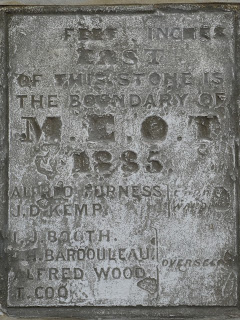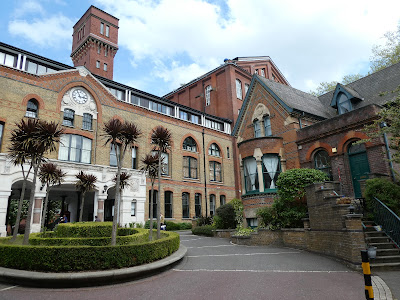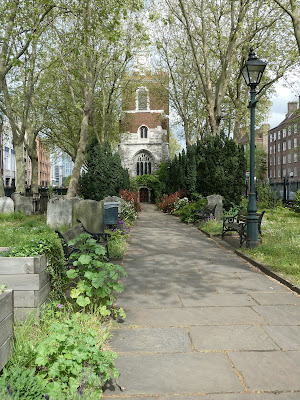A left turn off the Mile End Road and you are in another, more gentile world, the Tredegar Estate. This is a series of streets and squares laid out on land owned by the Baron of Tredegar, hence they all have Welsh names which seems rather incongruous in the East End. It was constructed between 1820 and 1860 so late Georgian early Victorian really, although all in what I would describe as Georgian style. This is as handsome a district to live in as any in London.
On one wall is the boundary stone marking the boundary of MEOT (Mile End Old Town)
Cutting across to the other side of Mile End Road one comes to another different world - the nether world. For here is 27 acres of dead people - Tower Hamlets cemetery. It is another of the Magnificent Seven - the grand Victorian cemeteries opened on what were then generally plots on the outskirts of London to take in the burgeoning middle class deceased. It doubles as a nature reserve. It is pretty heavily wooded and at this time still quite well endowed with blooming bluebells. I enjoyed pottering around it.
This is St Clements Hospital, although its hospital days are long over. It is well on the way to being converted into a housing estate, and a pretty one at that. Victorian buildings tend to convert well to other uses.
The fine house below, as you can see, was once home to Dr Barnardo
The Central Foundation School, formerly the Coburn School for Girls.
A memorial to former Labour Party leader (in the 1930s) George Lansbury. His granddaugher is Angela Lansbury, best known for portraying the detective Ms Marple.
This building is worthy of remark as a memorial to the changing culture of Bow. It was a built in classical style as a Congregationalist Chapel in 1836, became a synagogue in 1927 and is now a Sikh Gurdwara.
This is a much more modest edifice - Byas House built as social housing in the 1930s
Back on the main road there is further really grand terracing
The Victorian terraces give way to Bow police station, dating from 1903. It is a pretty familiar design for a police station as its designer, John Dixon Butler, designed about 200 across the metropolitan area. Sylvia Pankhurst was its most famous former detainee.
Bow Bells pub
An art deco business centre which could do with some cleaning up.
This is the former Bryant & May match factory, now another middle class enclave of upmarket apartments.
Grove Hall Park which sadly lacks a hall. Not the nicest of parks.
One can exit the park through this little alleyway which houses the Nunnery - an arts centre.
And finally one comes to the sad little St Mary's Church of Bow. Sad because it has now become stranded in the middle of Bow Road next to Bow Flyover. You have to be quite determined to visit it as the traffic here is not insignificant and that doesn't make for a quiet atmosphere of contemplation when you reach it. It also on quite a tight site - you can only just squeeze down the side to get to the graveyard at the back.
At the front of the church is a statue to William Gladstone.































































































No comments:
Post a Comment